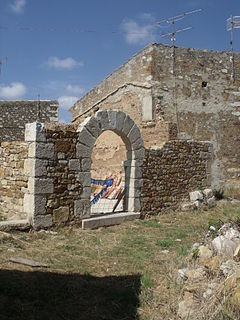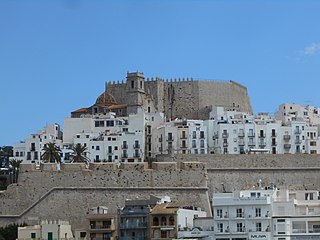 W
WThe Atalaya Castle is a castle in Villena, province of Alicante, southern Spain. Located over a spur of the Sierra de la Villa, in the north-western part of the province of Alicante, it commands the former frontier between Castile and Kingdom of Aragon.
 W
WThe Barxell Castle, located in the municipality of Alcoy, Alicante, Spain, is a 13th-century medieval building which stands on a rocky mound in the middle of a pine forest. It is next to the CV-795 road, between Alcoy and Banyeres de Mariola. It is located in the rural place of Barxell at 800 metres altitude. It is very close to the "Solanetes" which had a small population in the Muslim era.
 W
WCastillo o Torre is located in La Torre d'En Besora, comarca of Alt Maestrat, Castellón, Valencia, Spain. The ruins are classified as a Bien de Interés Cultural landmark, "Monumento por declaración genérica". The town of La Torre d'En Besora began as an Arab farmhouse, though archaeological investigations later came to believe that there might have been previous Iberian settlement in the area. This settlement was known as "Vinrabino", and it had a defensive tower, as was common at the time. After the troops of Jaime I of Aragon reconquered these lands, the settlement was renamed "Tower of Vinrabí", and it was subsequently affiliated with Blasco de Alagón, Guillem de Anglesola, and Ramon de Besora. During the time of Besora, he was awarded the Town Charter on January 5, 1274. He decided to rebuild, in part, the tower of the old Muslim farmstead, and added an adjoining fortified manor house next to it. The village which grew around it became known as "La Torre d'En Besora", Hispanicized as "Torre de Embesora", and it came to mean "Torre del señor Besora". Over time, the strategic importance of the castle diminished, which led to its abandonment and ruin. Some of its materials were used for the construction of the parish church of St. Bartholomew during the 18th century.
 W
WCastle Alcázar of Segorbe was an alcázar located on the slopes of Sopeña in the town of Segorbe, in the Valencian Community of Spain. Very little remains of the original alcázar, but the large complex was a residence of lords, dukes and kings for over a millennium.
 W
WCastle of Aixa, also known as Castell de la Solana, consists of the remains of the ancient castle in the mountains of the Castellet de Aixa in the highest part of Beniquesi, a location in the municipal district of Alcalalí (Spain), 600 meters above sea level, between Llosa de Camacho and Jalón and covering the entire Pop Valley.
 W
WThe Castle of Ayora is located at an elevation of 552 (1,811 ft) metres above mean sea level (mamsl), in the centre of Ayora, a Valencian town. Built probably in the mid 13th century, after the Reconquista, on an ancient Arabian building. The architectural ensemble was composed of the four-storey residence-palace, two fortified towns, and one large keep, as well as other rooms for the soldiers and serfdom, aljibes and gardens. This was surrounded by around 0.62 miles of defensive walls and defensive towers.
 W
WThe castle of Banyeres de Mariola (Alicante), Valencian Community, (Spain) is an Almohad fortress built in the 13th century, which is situated on the tossal de l'Àguila (val), eng: hill of the eagle, in the geographical center of Banyeres, with an elevation of 830 meters above the sea level.
 W
WThe Castle of Biar stands on a hillock overlooking the town of Biar, in the comarca of Alt Vinalopó.
 W
WThe Castle of Cocentaina, located in the municipality of Cocentaina, Alicante, Spain, is a 14th-century medieval building which stands on a rocky mound of 765 m. The castle structure, recently restored, is one of the town's symbols. The tower is a square two-story structure. On the first floor there is an open patio with a well, a chapel and a warehouse. On the upper floor, where the lords lived, there is a cornice with battlements and a path for guards. The castle is a good example of military gothic style.
 W
WThe Palace of Milà i Aragó, also known as the palace of the marquises of Albaida, is regarded as the most emblematic building of the town of Albaida, Valencian Community, Spain. It is considered a Place of Cultural Interest. Nowadays, in its interior there is a tourist office and the Museu Internacional de Titelles d'Albaida.
 W
WPeniscola Castle is a castle in Peniscola, Castellón, Valencian Community, Spain. The castle is restored and is open to the public.
 W
WThe Route of the castles of Vinalopó is a historic and cultural route in Spain, connecting some of the castles of the province of Alicante, Valencian Community, most of them based in the Valley of Vinalopó.
 W
WSagunto Castle is a fortress overlooking the town of Sagunto, near Valencia in Spain. The site's history extends back over two thousand years and includes Iberian, Roman and medieval remains. During the Islamic period, the castle was known as Murbĩtar and Morvedre. The castle was declared a National Monument in 1931.
 W
WSesga castle, which owes its name to the nearby hamlet, is also known as the "castillo de los moros". It is located in the municipality of Ademuz in the province of Valencia, Spain.
 W
WThe Tower and walls of the Borgias of the Valencian municipality of Canals (Spain), is a Bien de Interés Cultural with the code 46.23.081-003 and Ministerial annotation R-I-51-0010524 with date April 3, 2000. Is also known in valencian as Torreta de Canals.
 W
WThe Tower of Paterna is a historical monument of the town of Paterna, in the province of Valencia, Spain.
 W
WXativa Castle is a castle located in the city of Xàtiva near Valencia, Spain. It is strategically located on the ancient roadway Via Augusta leading from Rome across the Pyrenees and down the Mediterranean coast to Cartagena and Cádiz.